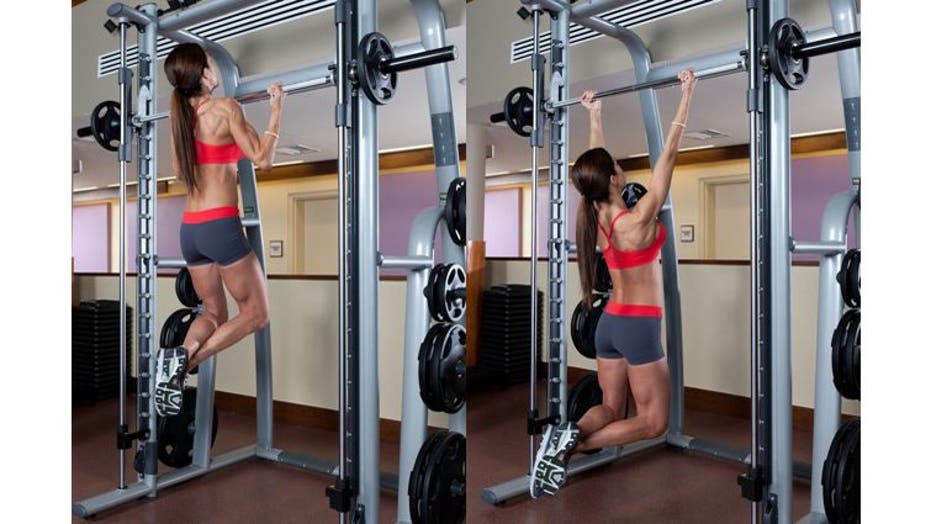When you do a set of pull-ups as part of your back routine, whether with the pull-up machine or old school, you probably feel some tension in your biceps and even chest. Pull-ups are an example of a multi-joint exercise, which is designed to engage several joints and muscle at the same time.
However, there is always one primary muscle or muscle group that acts as the primary mover. In this case the back muscles. The biceps and chest benefit from the up and down workout, but they also need to be in proper shape to assist the movement, otherwise you will fatigue sooner and cannot do as many reps.
Indeed, when researchers tested three different pull-up exercises—changing the grip position for each one—they found that while the lats were activated the most, the biceps and the pectorals muscles were highly stressed, concludes a study published in the Journal of Strength & Conditioning Research. So if you struggle with pull-ups, you may need to work your biceps and chest to better isolate the back muscles and take the stress off them.
An Exercise Helper
It’s a funny scenario. Your secondary muscle need to be strong so you can work the main muscles more. This is true for many common exercises. For instance, if you find yourself bending forward when doing a squat, the problem may lay in a weak core or tight hip flexor. If this is the case, adding another core-leg exercise—either to stretch the muscles or strengthen them—to your routine may help you better perform the workout.
The body’s ability to adapt is impressive. When performing an exercise, the neuromuscular system kicks in first to recruit the appropriate motor units and coordinate the movement pattern, through both feed forward and feedback mechanisms. Meanwhile, the appropriate metabolic adjustments occur depending on your training plan (i.e. an increase in strength, muscular endurance, hypertrophy, or some combination).
Mastering every exercise is critical to produce the right mechanical and physiological stress to help you reach your fitness goals and avoid injuries. Otherwise, you may be over-emphasizing the workload on some muscles and joints, while making others weaker along with creating erroneous motion patterns.
Master It
There are some common exercises you see many people struggle to correctly perform. Besides the pull-up and squat, these also include the chest press, dips, and plank just to name a few. These exercises involve the use of multiple muscle groups in a coordinated manner. Some of these muscle groups may act as prime movers, while others may act as assistant movers, stabilizers, neutralizers, or antagonists.
Here, Brian Biagioli, Ed.D., Executive Director NCSF and Jeff Plasschaert, MS, CSCS, USAT and USA Coach, explains what are the best exercises to help overcome most common issues when performing these common gym moves:
Squat: to improve your technique in the back squat or front squat, practice the Bulgarian squat, says Biagioli. While this may seem counter-intuitive, the Bulgarian squat will help correct some common barriers while squatting, such as stabilize the pelvis, stretch the trunk and the hips and better activation of the inner abdominal muscles.
Free weights chest press: do a single arm cable chest press on your knees—instead of standing. Plasschaert says this helps stabilize the core and put more emphasis on shoulder stabilization. Another alternative is internal and external shoulder rotations. Biagioli adds these exercises will not just improve the shoulder joint stability, but also reduce the joint capsule tightness.
Pull-ups: the experts recommend two exercises to master the pull-ups. The bent over face pulls with a resistance band or cable, and hanging leg raises to promote trunk stability and upper body isometric strength. For the bent over face pulls, begin in a bent-over position (similar to bent over row) and hold the band out in front of your with a shoulder-width grip. Bring your hands to shoulder level and pause. Return to starting position. For the hanging leg raises, use an overhand grip and grab onto a bar, while keeping your body in a straight line. Keeping your upper body still, lift your legs out in front of you. Hold briefly at the top of the motion, and then slowly lower to the starting position. Move in a slow and controlled manner so momentum does not take over.
Dips: perform an elevated between box push-ups. Place two boxes or benches (height relative to strength) at the desired width apart. Place your hands on both sides and push-up in between the benches to optimize range of motion and joint stability.“It provides for better synergy to shoulders, pecs and trunk,” says Biagioli.
Plank: perform a lateral hand walk over a step. Begin by placing a 4-inch step on the floor and kneeing behind it. Place both hands shoulder-width apart, arms straight, and a theraband around your wrists/forearm. Starting in the plank position, “step down” with one hand beside the step and bring the other hand to the floor. Then “step up” so both hands are on top of the step. Repeat to the other side to complete one rep, says Plasschaert.
Barbell/DB Step-up: to improve your step-up, practice doing a reverse lunge to a knee-raise. Biagioli explains this will promote glutes/ham extension force coupling as well as balance. Plasschaert says another to help overcome muscle weakness when performing the step up is a single leg heel-tap. This exercise is performed on a step while standing on one leg (with the knee slightly bent. The free leg is lowered to the ground with the ankle in a dorsiflexed position until the heel taps lightly on the ground and then is raised back to the starting position. Increase the height of the step for added difficulty.
Lunge With Knee Raise (above): step back into a lunge position. Sit back to 90 degree angle and return while simultaneously lift the other leg. Use the gluteus and the core to keep the hips and the back straight.

